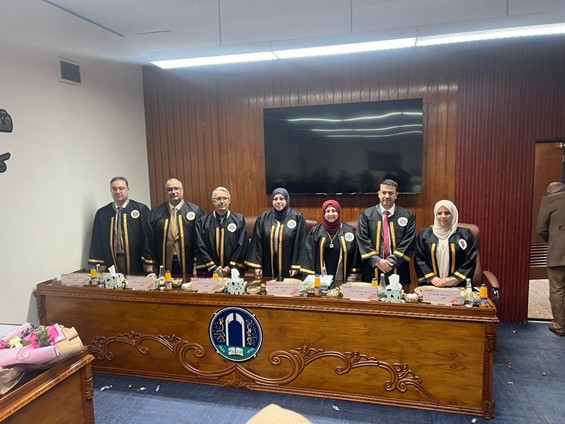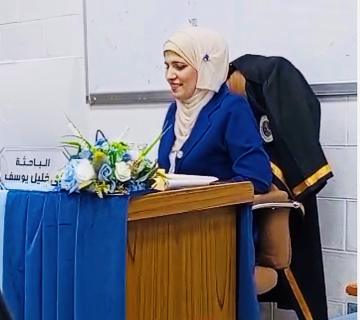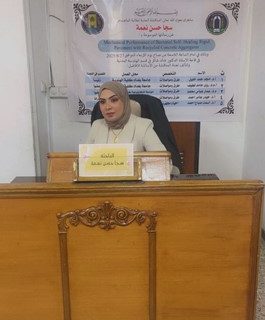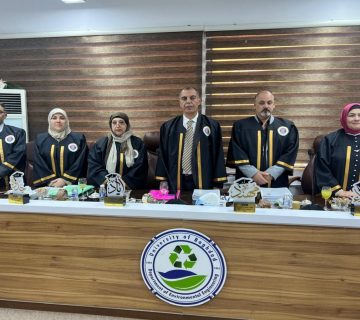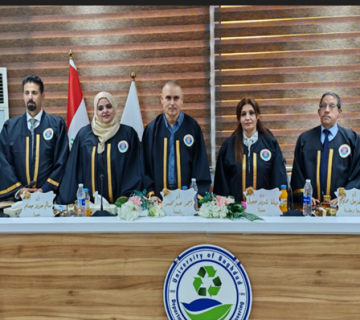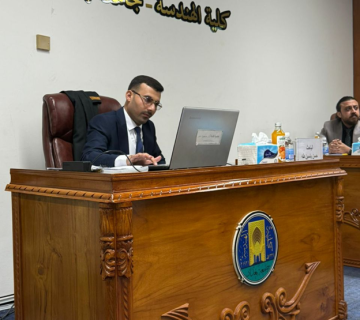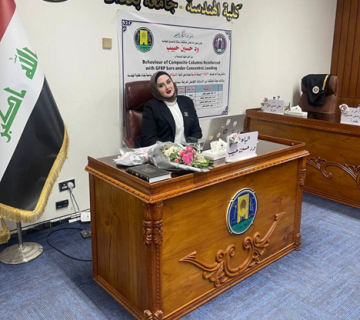The Chemical Engineering Department at the College of Engineering, University of Baghdad, held a Ph.D thesis examination titled:
“Synthesis and Characterization of Mesoporous SBA-15 Support for Catalytic Hydrodesulfurization of Iraqi Gas Oil“
By the student Yousra Saber Kareem and supervised by Prof. Dr. Hussien Qasim Hussien. The examination committee consisted of Prof. Dr. Najwa Saber Majeed as Chairman and the membership of Prof. Dr. Saad H. Ammar, Prof. Dr. Haider A. Al-Jendeel, Prof. Dr. Sama M. Al-jabouri and Asst. Prof. Dr. Tariq M. Naife. After conducting the public discussion and listening to the student’s defense, the thesis was accepted. The thesis was summarized as follows:
This work deals with the Hydrodesulfurization of Iraqi gas oil with 14089 ppm sulfur content obtained from the Al-Dora refinery using prepared NiMo/SBA-15 and NiMoW/SBA-15 mesoporous catalysts.
The successful synthesis of sodium silicate, a key component used as a silica source during the preparation of SBA-15, was achieved using 84% silica-rich sand located in the western desert of Iraq by dry fusion method. The effect of NaOH/sand weight ratios between 1 -1.4 at different fusion temperatures between 400 – 600°C on the properties of synthesized sodium silicate was studied.
The successful synthesis of mesoporous Santa Barbara amorphous (SBA-15) with nanoparticle size distribution, different texture properties, and morphologies was a significant achievement. This was attempted by hydrothermal method using prepared sodium silicate as a silica source, and tri-block copolymer P123 as a template in a strong acid medium (pH < 1). The mixtures were mixed using repining conditions of 35°C at 24 hrs. and aged in a jar test in an oven set at conditions of 100°C for 24 hrs. The aged mixture was filtered, washed, dried at a temperature of 100℃ for a duration of 24 hr., and calcined at a temperature of 550℃ for a duration of 6 hrs. The above procedure was repeated using commercial sodium silicate.
The study focused on analyzing the impact of various parameters on the synthesis of mesoporous SBA-15. 1-3g of three dispersing agents: Polyvinyl Alcohol (PVA), Polyvinyl Pyrrolidone (PVP), and Sodium Dodecyl Sulfate (SDS). Additionally, 1g of co-surfactants such as Cetyltrimethylammonium Bromide (CTAB) as a cationic surfactant, Pluronic F68 as a nonionic surfactant, and Sodium Dodecyl Benzene Sulfonate (SDBS) as an anionic surfactant., different ageing temperatures of 100 -130°C. different aging times of 24 -120 hrs., and a combination of all variables above.
All prepared samples of sodium silicate, SBA-15, and the commercial one were characterized by X-ray diffraction (XRD), Fourier Transform infrared spectroscopy (FTIR), energy dispersive X- X-ray spectroscopy (EDS), pH measurement, Atomic force microscopy (AFM), Brunauer, Emmet, and Teller (BET), and Field emission scanning electron microscopy (FESEM).
The results obtained show that all the prepared samples of sodium silicate represent alkaline type. Also, the closest properties to the commercial sodium silicate were estimated at conditions of 1 NaOH/sand wt. ratio at 600°C.
The XRD and FTIR tests represent amorphous SBA-15 with silanol (Si=O) and siloxane (Si-O-Si) main chemical groups. AFM tests indicate that all prepared samples have a nano average particle size distribution. All the variables except ageing time used to synthesize SBA-15 have a clear influence on the surface area with no effect on the pore size The texture properties of prepared SBA-15 samples were between 210-900 m2/g surface area, 0.17-0.7 cm3/g pore volume, and 1.92-13.45 nm pore size. The highest values of the surface area were recorded at conditions of using 1g CTAB at ageing conditions of 100°C for 24 hrs., while the highest values of pore volume and pore size were obtained without any additives at ageing conditions of 120°C for 120 hrs. Using of a combination of all variables produces superior texture properties of 540 m2/g surface area, 0.85 cm3/g pore volume, and 8.83 nm pore size, with average nanoparticle size reaching 72.98nm, so these experiments were used as a support during the preparation of Hydrodesulfurization catalysts. The morphology of prepared SBA-15 samples was transferred from spherical and semi-spherical shapes to small rods and platelet shapes at different conditions.
Using nano γ alumina as an inorganic binder and poly acrylic amide as an organic binder, prepared SBA-15 was successfully moulded to an extrudate shape with a slight decrease in surface area.
A co-wet-impregnation technique was used to prepare NiMo/SBA-15 with metal loadings of 5% and 17% of Ni and Mo oxides, respectively, while NiMoW/SBA-15 was prepared by loading 5% NiO and 14% of both MoO3 and WO3.
The HDS activity of both prepared catalysts was tested at reaction temperatures between 275 to 350°C, liquid hour space velocity between 1-4 hr-1, 40 bar hydrogen pressure, and an H2/HC ratio of 200/200 ml/ml.
It was concluded that NiMoW/SBA-15 has higher activity for HDS of gas oil than NiMo/SBA-15. The sulfur removal percentages reached their optimum values of 60, and 75% using NiMo/SBA-15, and NiMoW/SBA-15 respectively at conditions of 350°C, and LHSV 1hr-1.
The Hydrodesulfurization data fitted a second-order kinetic model. The activation energies of HDS of gas oil were 33, and 50.47 KJ/mole using NiMo/SBA-15, and NiMoW/SBA-15 respectively.

